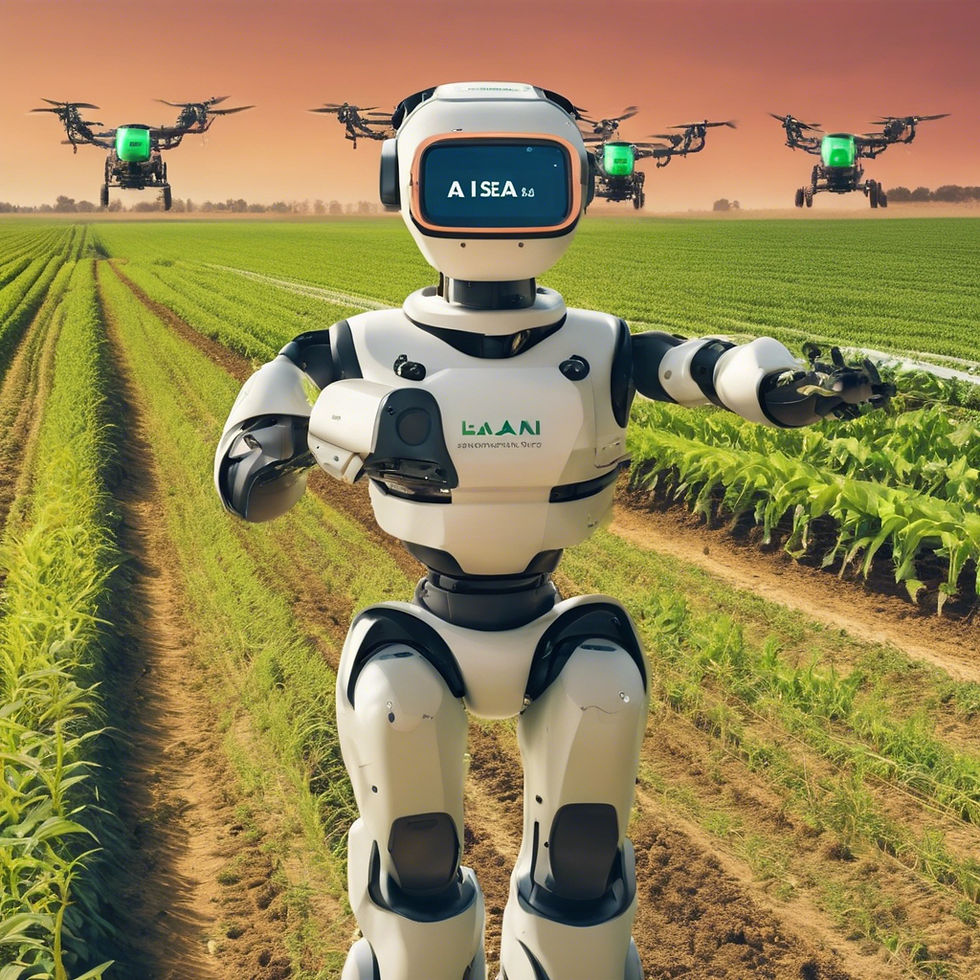AI Agents for Smarter Agricultural Revolution
- DikshaAI
- Jun 14, 2024
- 5 min read
The global agriculture industry is at a critical juncture. As the population grows, the demand for food increases, but traditional farming methods struggle to keep up. Enter AI agents, and digital innovators ready to transform agriculture.
Rather than replacing farmers, think of AI agents as advanced tools. Powered by machine learning and data analysis, these agents can monitor crops, manage resources, and predict future yields with impressive accuracy.
Imagine a field equipped with sensors that continuously provide information about soil health, moisture levels, and pest presence. AI agents take this data and turn it into practical insights, enabling farmers to make informed decisions about irrigation, fertilization, and pest control.

How is AI applied in the agriculture industry?
AI is being applied in diverse and impactful ways across the agricultural industry. Here are some key examples:
Precision Farming: AI analyzes data from various sources like satellites, drones, and sensors to provide farmers with real-time insights into soil health, crop health, and weather patterns. This allows for precise application of resources like water and fertilizer, optimizing yield and minimizing waste.
Disease and Pest Detection: AI algorithms can analyze images of crops to identify signs of disease or pest infestations at an early stage, often invisible to the naked eye. This early detection enables timely intervention, preventing widespread damage and reducing reliance on pesticides.
Automated Irrigation: AI-powered systems can monitor soil moisture levels and weather forecasts to automatically adjust irrigation schedules, ensuring crops receive the optimal amount of water, conserving resources, and improving efficiency.
Predictive Analytics: AI can analyze historical data and weather patterns to predict future yields, helping farmers make informed decisions about planting, harvesting, and resource allocation.
Cultivating Success: Best Practices for Implementing AI Agents
The potential of AI agents in agriculture is undeniable, but successful implementation requires careful planning and execution:
Start with a Clear Objective: Don't just jump on the AI bandwagon because it's trendy. Identify specific pain points in your operation that AI can address, whether it's optimizing irrigation or detecting disease early.
Data is King (and Queen): AI agents thrive on data. Ensure you have reliable systems for collecting, storing, and cleaning data from various sources like sensors, weather stations, and even satellite imagery.
Embrace Collaboration: Building a robust AI infrastructure requires expertise in data science, software engineering, and of course, agriculture. Partner with technology providers and research institutions to bridge the knowledge gap.
Start Small, Scale Gradually: Begin with a pilot project to test the waters before a full-scale rollout. This allows you to fine-tune the system and demonstrate its value.
Invest in Training: AI agents are powerful tools, but they need human guidance. Train your workforce to understand, operate, and interpret the insights provided by these digital assistants.
From Field to Fork: Use Cases and Examples of AI Agents in Action
Let me paint a picture of how AI agents are transforming real-world agriculture:
Precision Farming with a Digital Eye: AI-powered drones and robots equipped with computer vision can identify and target weeds with pinpoint accuracy, minimizing herbicide use and environmental impact. Companies like Blue River Technology are already using this technology to revolutionize weed control.
Predictive Analytics for Proactive Farming: Imagine predicting crop diseases before they even manifest! AI agents analyze historical and real-time data to identify patterns and predict potential outbreaks, allowing for timely interventions. This saves crops and reduces reliance on pesticides.
Optimizing Resource Allocation: Water scarcity is a growing concern. AI agents monitor soil moisture, weather patterns, and even individual plant needs to create highly efficient irrigation schedules, conserving water without sacrificing yield.
Livestock Monitoring for a Healthier Herd: From facial recognition to tracking individual animals to analyzing behavioral data to detect signs of illness, AI agents are transforming livestock management. This leads to early disease detection, reduced antibiotic use, and improved animal welfare.
FAQs about AI in Agriculture
1. What is the use case of AI in agriculture?
AI in agriculture encompasses a vast range of applications. From optimizing irrigation and detecting crop diseases early to automating tasks like harvesting and even predicting market trends, AI agents are transforming every aspect of the industry.
2. How can AI help farmers, specifically those in class 9?
AI can be a valuable tool for farmers of all levels, including those just starting. For class 9 farmers, AI can:
Simplify complex data: AI can analyze data from various sources and present it in a user-friendly format, making it easier for young farmers to understand their farm's needs.
Offer personalized recommendations: Based on data analysis, AI can suggest the best crops to grow, optimal planting times, and efficient irrigation strategies tailored to the specific conditions of their farm.
Facilitate learning: AI-powered platforms can provide access to educational resources, connect farmers with experts, and foster a community of knowledge sharing.
3. What artificial intelligence tools help in monitoring plant growth and health remotely?
A range of AI tools facilitate remote monitoring of plant growth and health, empowering farmers with real-time insights and proactive management capabilities:
Drones equipped with multispectral or hyperspectral cameras: These capture images beyond the visible spectrum, revealing details about plant health invisible to the naked eye.
Ground-based sensors: These sensors, strategically placed within fields, continuously monitor factors like soil moisture, nutrient levels, and temperature, providing valuable data for AI analysis.
Satellite imagery: High-resolution satellite images offer a bird's-eye view of entire fields, enabling AI algorithms to detect patterns and anomalies in crop growth.
4. What is the full form of AI in farming?
AI stands for Artificial Intelligence, representing the simulation of human intelligence processes by computer systems. In farming, AI encompasses a wide range of technologies that enable machines to perform tasks that typically require human intelligence, such as learning, problem-solving, and decision-making.
5. What are the challenges of implementing AI in agriculture?
While the potential of AI in agriculture is vast, it is essential to acknowledge the challenges that come with its implementation:
Data Privacy and Security: The collection and analysis of vast amounts of data raise concerns about privacy and security, requiring robust safeguards and ethical considerations.
High Initial Investment: Implementing AI-powered systems often involves significant upfront costs, potentially posing a barrier for small-scale farmers.
Lack of Digital Literacy: Successful adoption of AI requires a certain level of digital literacy, which may be lacking in some farming communities.
Addressing these challenges through education, government support, and collaborative initiatives will be crucial to unlocking the full transformative potential of AI in agriculture.
The Future is Ripe with Possibilities
As someone who has witnessed firsthand the transformative power of technology, I am incredibly excited about the future of AI in agriculture. This isn't about replacing farmers but empowering them with the tools they need to feed a growing world sustainably and efficiently. The seeds of this digital revolution have been sown, and I do not doubt that the future harvest will be bountiful.





Comments